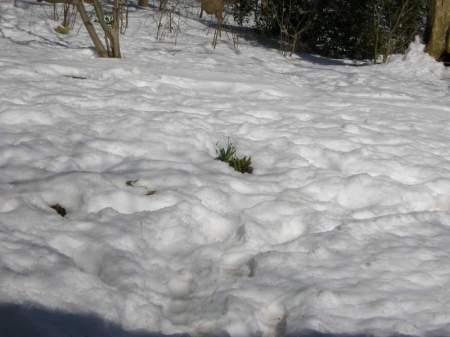Carolyn’s Shade Gardens is a retail nursery located in Bryn Mawr, PA, specializing in showy, colorful, and unusual plants for shade. The only plants that we ship are snowdrops to the US only. For catalogues and announcements of local events, please send your full name, mailing address, and cell number to carolyn@carolynsshadegardens.com and indicate whether you are mail order only. Click here to get to the home page of our website for catalogues and information about our nursery and to subscribe to our blog.
 Galanthus ‘Dionysus’, a Greatorex double
Galanthus ‘Dionysus’, a Greatorex double
.
Our current snowdrop catalogue is on line here.
.
Snowdrops are some of the earliest blooming flowers in my garden, often popping up through the snow, hence their name. We all love them for that, but how do they do it? I have been told several times that they are thermogenic, that is, that they produce their own heat, and decided to do some scientific research to find out (it can’t all be about pretty photos).
 Common snowdrop, Galanthus nivalis, and “spring-blooming” hardy cyclamen ‘Rose’, Cyclamen coum ‘Rose’, in my rock garden
Common snowdrop, Galanthus nivalis, and “spring-blooming” hardy cyclamen ‘Rose’, Cyclamen coum ‘Rose’, in my rock garden
Over 200 years ago, French biologist, Jean-Baptiste de Lamarck, noticed that some flowers produce their own heat. Since then, scientists have confirmed that some plants can, in fact, generate their own heat, a process known as thermogenesis, previously thought to be limited to mammals, birds, and some flying insects. These plants are “warm-blooded”.
 Holes in the snow produced by eastern skunk cabbage, Symplocarpus foetidus, performing thermogenesis, photo Robert Klips
Holes in the snow produced by eastern skunk cabbage, Symplocarpus foetidus, performing thermogenesis, photo Robert Klips
The poster child for thermogenesis is the eastern skunk cabbage, Symplocarpus foetidus, which is native to most of eastern North America. Its flower, pictured below (courtesy of Robert Klips, Ohioense: Bob’s Brain on Botany, March 8, 2010), heats up to melt the snow producing little circles all over the woods in late winter. It does this primarily to generate and disperse its floral scent to attract pollinators. In this case, the scent is rotten meat and the pollinators are flies and beetles. Secondarily, it rewards the insects by providing them with energy directly as heat rather than indirectly as nectar and pollen.
 Eastern skunk cabbage blooming through the snow, photo Robert Klips
Eastern skunk cabbage blooming through the snow, photo Robert Klips
This is no small feat. Skunk cabbage flowers can heat up to 59 degrees F (15 degrees C) when the ambient temperature is 5 degrees F (-15 degrees C). They can also thermoregulate, adjust their temperature, to maintain a constant setting as the ambient temperature changes. If the outside temperature gets too low, they will switch off their heat entirely until things warm up. They also switch off the heat once they have been pollinated.
 Eastern skunk cabbage peeking out of its snow cave, photo Robert Klips
Eastern skunk cabbage peeking out of its snow cave, photo Robert Klips
To perform thermogenesis, skunk cabbage uses as much metabolic energy as a small rodent or a hummingbird and employs a unique respiratory process, which is more similar to animal metabolism than plant metabolism though biochemical rather than nervous system based. The exact nature of this process is unknown. For those of you with a scientific bent, I have included a graph below taken from a scholarly treatise on the subject, Temperature Regulation by Thermogenic Flowers (Plant Physiology Online, Sept. 2006).
 Graph of oxygen consumption and heat production by skunk cabbage in various ambient temperatures
Graph of oxygen consumption and heat production by skunk cabbage in various ambient temperatures
But, now that you understand thermogenesis, back to the question at hand: are snowdrops thermogenic? The short answer is I don’t know. Various sources say that they are, but the statements seem to be based on hearsay. I could find no scientific studies backing them up. I posted the question on the Pacific Bulb Society forum, the Scottish Rock Garden Club forum, and to friends at Longwood Gardens, and no one could confirm that snowdrops are thermogenic. So I present my own “scientific study” of the process.
 February 21, 2010, at Carolyn’s Shade Gardens, three tiny islands are appearing in the snow
February 21, 2010, at Carolyn’s Shade Gardens, three tiny islands are appearing in the snow
As you know from my previous post, The Joys and Sorrows of Snow, we had record snowfall during the winter of 2009-2010. By February, my whole garden was covered by a deep, thick, hard layer of snow. Looking out on the landscape in the photo above, there was absolutely no melting going on except in three small areas. What is happening in those little circles? Let’s look closer:
 Giant snowdrop, Galanthus elwesii, melting through the snow
Giant snowdrop, Galanthus elwesii, melting through the snow
And even closer:
 Giant snowdrop blooming in February after melting through the snow pack
Giant snowdrop blooming in February after melting through the snow pack
My observations prove nothing scientific, but they do indicate that something is going on. And I like to think that one of my favorite plants, snowdrops, which inspire such intense interest in many gardeners, also produce their own internal excitement.
For my previous articles on snowdrops, click here and here.
Please let me know in a comment/reply if you have any knowledge or personal experience with snowdrops being thermogenic.
Carolyn
Notes: Every word that appears in orange on my blog is a link that you can click for more information. If you want to return to my blog’s homepage to access the sidebar information (catalogues, previous articles, etc.), click here.




